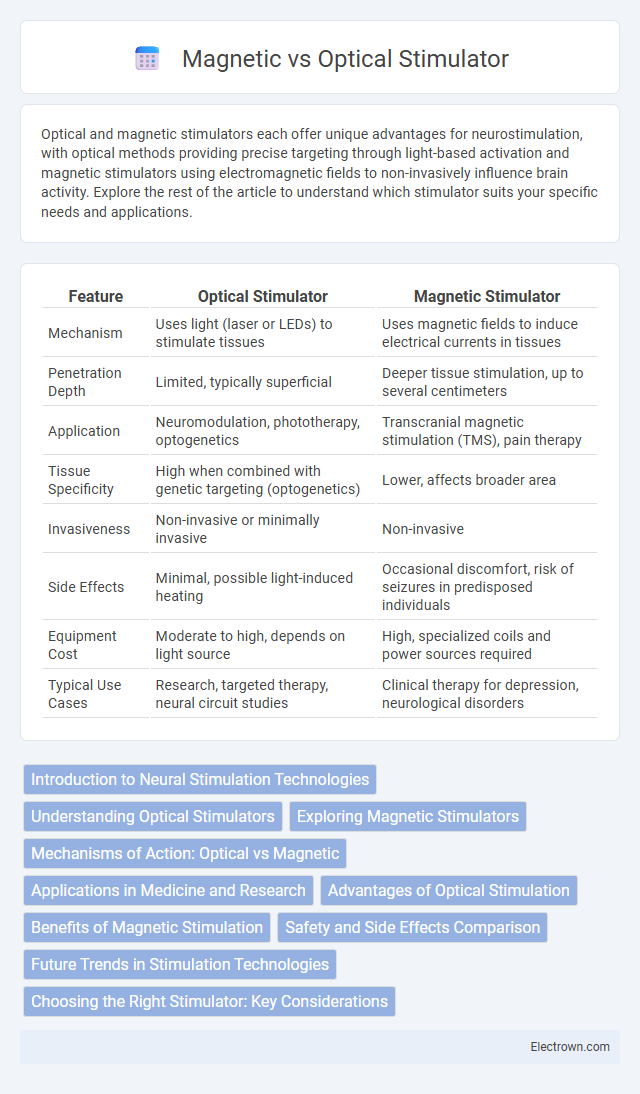Optical and magnetic stimulators each offer unique advantages for neurostimulation, with optical methods providing precise targeting through light-based activation and magnetic stimulators using electromagnetic fields to non-invasively influence brain activity. Explore the rest of the article to understand which stimulator suits your specific needs and applications.
Table of Comparison
| Feature | Optical Stimulator | Magnetic Stimulator |
|---|---|---|
| Mechanism | Uses light (laser or LEDs) to stimulate tissues | Uses magnetic fields to induce electrical currents in tissues |
| Penetration Depth | Limited, typically superficial | Deeper tissue stimulation, up to several centimeters |
| Application | Neuromodulation, phototherapy, optogenetics | Transcranial magnetic stimulation (TMS), pain therapy |
| Tissue Specificity | High when combined with genetic targeting (optogenetics) | Lower, affects broader area |
| Invasiveness | Non-invasive or minimally invasive | Non-invasive |
| Side Effects | Minimal, possible light-induced heating | Occasional discomfort, risk of seizures in predisposed individuals |
| Equipment Cost | Moderate to high, depends on light source | High, specialized coils and power sources required |
| Typical Use Cases | Research, targeted therapy, neural circuit studies | Clinical therapy for depression, neurological disorders |
Introduction to Neural Stimulation Technologies
Neural stimulation technologies harness targeted energy forms to modulate neural activity, with optical stimulators using light to activate neurons and magnetic stimulators employing electromagnetic fields to induce electrical currents. Optical stimulation offers high spatial precision and cell-type specificity, making it ideal for applications requiring fine control of neural circuits, whereas magnetic stimulation provides non-invasive depth penetration suitable for broader brain regions. Your choice between optical and magnetic stimulation depends on the desired neural targeting, invasiveness, and clinical or research objectives.
Understanding Optical Stimulators
Optical stimulators utilize light, often lasers or LEDs, to activate or modulate neural activity with high spatial and temporal precision, contrasting with magnetic stimulators that employ magnetic fields to induce electrical currents in brain tissue. These devices enable targeted stimulation of specific neurons or circuits, offering advantages in minimally invasive neuromodulation and optogenetics research. Optical stimulation's ability to selectively excite or inhibit cells enhances its application in studying neural dynamics and treating neurological disorders.
Exploring Magnetic Stimulators
Magnetic stimulators use pulsed electromagnetic fields to non-invasively activate neural circuits, offering deeper tissue penetration compared to optical stimulators. These devices are widely utilized in transcranial magnetic stimulation (TMS) therapies for neurological disorders such as depression and chronic pain, leveraging their ability to modulate brain activity without direct tissue contact. Your treatment options can significantly benefit from magnetic stimulation's precise targeting and reduced invasiveness relative to optical methods.
Mechanisms of Action: Optical vs Magnetic
Optical stimulators utilize light, often near-infrared wavelengths, to activate neurons by inducing photothermal or photochemical effects that alter cellular activity. Magnetic stimulators generate rapidly changing magnetic fields that induce electrical currents in neural tissues, leading to depolarization and modulation of neuronal firing. Your choice between optical and magnetic stimulation depends on the specific neural targets and desired precision of intervention.
Applications in Medicine and Research
Optical stimulators offer precise, non-invasive control of neural activity using light, making them ideal for optogenetics in neurological disorder research and targeted therapies. Magnetic stimulators, such as transcranial magnetic stimulation (TMS), are widely used for non-invasive brain stimulation to treat depression, anxiety, and other psychiatric conditions by modulating neural circuits. Your choice between these technologies depends on the specific medical or research application, with optical stimulators excelling in cellular-level studies and magnetic stimulators being preferred for clinical neuromodulation.
Advantages of Optical Stimulation
Optical stimulation offers high spatial precision and minimal invasiveness compared to magnetic stimulators, enabling targeted activation of specific neurons with reduced tissue damage. This method provides faster response times and greater temporal resolution, enhancing the effectiveness of neuromodulation therapies. Your ability to control neural circuits with light improves diagnostic accuracy and therapeutic outcomes in neurological research and treatment.
Benefits of Magnetic Stimulation
Magnetic stimulation offers non-invasive pain relief, improved blood flow, and enhanced nerve regeneration by using pulsed electromagnetic fields to penetrate deeper tissues compared to optical stimulators. Its ability to target specific brain regions with precision supports treatments for neurological disorders such as depression and epilepsy without the discomfort or side effects often associated with invasive procedures. You can benefit from magnetic stimulation's longer-lasting therapeutic effects and increased stimulation depth, making it a versatile solution for both clinical and rehabilitation settings.
Safety and Side Effects Comparison
Optical stimulators use low-level light therapy to target nerves non-invasively, resulting in fewer side effects such as skin irritation or discomfort compared to magnetic stimulators, which utilize electromagnetic pulses that may cause mild headaches or scalp tingling. Safety profiles highlight that optical stimulation poses minimal risk of seizures or adverse neurological reactions, unlike magnetic stimulation that can rarely induce seizures in susceptible individuals. Choosing the right device for your treatment depends on weighing these safety considerations alongside therapeutic goals.
Future Trends in Stimulation Technologies
Future trends in stimulation technologies emphasize the integration of optical stimulators with advanced neuroimaging techniques to achieve precise spatial and temporal control, surpassing the limitations of traditional magnetic stimulators. Development in optogenetics and miniaturized photonic devices enables targeted neuronal modulation at cellular levels, offering customizable therapeutic approaches for neurological disorders. Magnetic stimulators continue to evolve with improved coil designs and real-time feedback systems, enhancing depth penetration and focality, but optical methods are increasingly favored for their specificity and reduced side effects.
Choosing the Right Stimulator: Key Considerations
Choosing the right stimulator depends on the target application, desired precision, and compatibility with your research or clinical goals. Optical stimulators offer high spatial resolution and are ideal for selective neural activation using light-sensitive proteins, while magnetic stimulators provide deeper penetration and non-invasive modulation suitable for broader brain regions. Evaluate factors such as stimulation depth, specificity, safety, and experimental requirements to ensure optimal outcomes with your chosen device.
Optical vs Magnetic Stimulator Infographic

 electrown.com
electrown.com